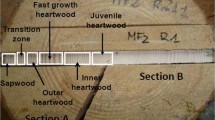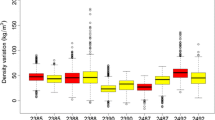Abstract
In spite of different studies describing the effect of interspecific variability on wood thermal degradation, no study describes the effect of intraspecific variability of wood. As physical properties as well as chemical composition of wood can vary between stands and even within tree, the effect of radial position of European oak wood (Quercus petraea Liebl.) on its thermal stability was investigated. Samples of heartwood, sapwood, juvenile wood, earlywood or latewood taken from the radii of two trees were ground to fine sawdust before subjecting to thermogravimetric analysis (TGA) at 220 °C for 2 h. At the same time, holocellulose, cellulose and extractives as well as extracted heartwood and sapwood were also subjected to TGA using the same procedure. Results indicated that heartwood was more sensitive to heat than sapwood, the inner side of heartwood being more sensitive than the outer side. Differences were also noticed between native and extracted wood, the latter being less sensitive to thermal degradation. These results were consistent with the stability of each wood cell wall component indicating that extractives were more susceptible to thermal degradation than holocellulose, holocellulose being more susceptible than cellulose. At the ring level, earlywood was shown to be more sensitive to thermal degradation than latewood.



Similar content being viewed by others
References
Adamopoulos S, Voulgaridis E, Passialis C (2005) Variation of certain chemical properties within the stemwood of black locust Robinia pseudoacacia L. Holz Roh Werkst 63:327–333
Agriculture Department (1998) Properties and use of wood, composites, and fiber products [Forest Service]/compl. Laboratory Forest Products. - 09 1998. Vol. VI. http://www.fpl.fs.fed.us/
Berberović A, Milota MR (2011) Impact of wood variability on the drying rate at different moisture content levels. For Prod J 61:435–442
Bodîrlau R, Spiridon I, Teaca CA (2007) Chemical investigation of wood tree species in temperate forest in east-northern Romania. BioResources 2:41–57
Boonstra MJ, Van Acker J, Tjeerdsma BF, Kegela EV (2007) Strength properties of thermally modified softwoods and its relation to polymeric structural wood constituents. Ann For Sci 64:679–690
Brosse N, El Hage R, Chaouch M, Pétrissans M, Dumarçay S, Gérardin P (2010) Investigation of the chemical modifications of beech wood lignin during heat treatment. Polym Degrad Stab 95:1721–1726
Candelier K, Chaouch M, Dumarçay S, Pétrissans A, Pétrissans M, Gérardin P (2011) Utilization of thermodesorption coupled to GCMS to study stability of different wood species to thermodegradation. J Anal Appl Pyrolysis 92:376–383
Candelier K, Dumarçay S, Pétrissans A, Desharnais L, Gérardin P, Pétrissans M (2013) Comparison of chemical composition and decay durability of heat treated wood cured under different inert atmospheres: nitrogen or vacuum. Polym Degrad Stab 98:677–681
Chaouch M, Pétrissans M, Pétrissans A, Gérardin P (2010) Use of wood elemental composition to predict thermal treatment intensity and decay resistance of different softwood and hardwood species. Polym Degrad Stab 95:2255–2259
Debell DS, Singleton R, Gartner BL, Marshall DD (2004) Wood density for young-growth western hemlock: relation to ring age, radial growth, stand density, and site quality. Can J For Res 34:2433–2442
Dharmdhikari M (1995) Oak wood composition, vol 10. pp 1–4. http://guides.library.missouristate.edu/content.php?pid=101274&sid=786875
Guilley E, Nepveu G (2003) Anatomical interpretation of the components of a wood density mixed model in sessile oak (Quercus petraea Liebl.): ring number from the pith, ring width, tree, inter-annual variation, heartwood formation. Ann For Sci 60:331–346
Guilley E, Hervé JC, Huber F, Nepveu G (1999) Modelling variability of within-rings density components in Quercus petraea Liebl. With mixed-effects models and simulating the influence of contrasting silvicultures on wood density. Ann For Sci 56:449–458
Hamada J, Pétrissans A, Mothe F, Ruelle J, Pétrissans M, Gérardin P (2016) Variations in the natural density of European oak wood affect thermal degradation during thermal modification. Ann For Sci 73:277–286
Kamdem D, Pizzi A, Jermannaud A (2002) Durability of heat-treated wood. Holz Roh Werkst 60:1–6
Kebbi-Benkeder Z, Colin F, Dumarçay S, Gérardin P (2014) Quantification and characterization of knotwood extractives of 12 European softwood and hardwood species. Ann For Sci 72(2):277–284
Kiaei M, Kord B, Chehalmardian A, Moya R, Farsi M (2015) Mineral content in relation to radial position, altitude, 3 chemical properties and density of Persian ironwood. Maderas-Cienc y Tecnol 17:657–672. doi:10.4067/S0718-221X2015005000058
Kimberley MO, Cown DJ, McKinley RB, Moore JR, Leslie J (2015) Modelling variation in wood density within and among trees in stands of New Zealand-grown radiata pine. N Z J For Sci. doi:10.1186/s40490-015-0053-8
Knapic S, Louzada JL, Leal S, Pereira H (2007) Radial variation of wood density components and ring width in cork oak trees. Ann For Sci 64:211–218
Knapic S, Louzada JL, Leal S, Pereira H (2008) Within-tree and between-tree variation of wood density components in cork oak trees in two sites in Portugal. Forestry 81:465–473
Koga S, Zhang SY (2002) Relationships between wood density and annual growth rate components in balsam fir (Abies balsamea). Wood Fiber Sci 34:146–157
Krutul D, Zawadzki J, Radomski A, Zielenkiewicz T, Antczak A, Sacharczuk A (2009) Distribution of high fatty acids in the cross section of the oak trunk (Quercus robur L.). Wood Res 54:119–128
Masson G, Moutounet M, Puech JL (1995) Ellagitannin content of oak wood as a function of species and of sampling position in the tree. Am J Enol Vitic 46:262–268
Morais MC, Pereira H (2012) Variation of extractives content in heartwood and sapwood of Eucalyptus globulus trees. Wood Sci Technol 46:709–719
Mosedale JR, Charrier B, Crouch N, Janin G, Savill PS (1996) Variation in the composition and content of ellagitannins in the heartwood of European oaks (Quearcus robur and Q petraea), A comparison of two French forests and variation with heartwood age. Ann For Sci 53:1005–1018
Murphy G, Cown D (2015) Stand, stem and log segregation based on wood properties. Scand J For Res 30:757–770
Nguila Inari G, Pétrissans M, Pétrissans A, Gérardin P (2009) Elemental composition of wood as a potential marker to evaluate heat treatment intensity. Polym Degrad Stab 94:365–368
Niamke FB, Amusant N, Kokutse AD, Chaix G, Charpentier JP, Adima AA, Kati-Koulibaly S, Jay-Allemand C (2010) Radial distribution of non-structural carbohydrates in Malaysian teak. Int J Biol Chem Sci 4:710–720
Poletto M, Zattera AJ, Santana RMC (2012) Thermal decomposition of wood: kinetics and degradation mechanisms. Biores Technol 126:7–12
Repellin V, Guyonnet R (2003) Evaluation of heat treated beech by non destructive testing [Author manuscript, published in: First European conference on wood modification]. Gand: [s.n.], April 3–4, 2003
Rowell RM, Pettersens R, Han JS, Rowell JS, Tshabalala MA (2005) Cell wall chemistry. Handbook of wood chemistry and wood composites. Taylor & Francis, London, pp 35–72
Shchupakivskyy R, Clauder L, Linke N, Pfriem A (2014) Application of high-frequency densitometry to detect changes in early- and latewood density of oak (Quercus robur L.) due to thermal modification. Eur J Wood Prod 72:5–10
Shebani AN, van Reenen AJ, Meincken M (2008) The effect of wood extractives on the thermal stability of different wood species. Thermochim Acta 471:43–50
Shen D, Xiao R, Gu S, Zhang H (2013) The overview of thermal decomposition of cellulose in lignocellulosic biomass. Cellul Biomass Convers. doi:10.5772/51883
Snakkers G, Nepveu G, Guilley E, Cantagre R (2000) Variabilités géographique, sylvicole et individuelle de la teneur en extractibles de chênes sessiles français (Quercus petraea Liebl.), polyphénols, octalactones et phénols volatils. Ann For Sci 57:251–260
Šušteršic Ž, Mohareb A, Chaouch M, Pétrissans M, Petrič M, Gérardin P (2010) Prediction of decay resistance of heat treated wood on the basis of its elemental composition. Polym Degrad Stab 95:94–97
Wimme N, Gierlinger R (2004) Radial distribution of heartwood extractives and lignin in mature European larch. Wood Fiber Sci 36:387–394
Windeisen E, Strobel C, Wegener G (2007) Chemical changes during the production of thermo-treated beech wood. Wood Sci Technol 41:523–536
Yalcin M, Sahin HI (2015) Changes in the chemical structure and decay resistance of heat-treated narrow-leaved ash wood. Maderas-Cienc Tecnol 17:435–446. doi:10.4067/S0718-221X2015005000040
Zobel BJ, Van Buijtenen JP (1989) Wood variation: its causes and control. Springer, Berlin
Acknowledgements
The authors gratefully acknowledge the Région Lorraine and Lab of Excellence ARBRE for PhD grant of the first author. LERMAB and LERFoB are supported by a grant overseen by the French National Research Agency (ANR) as part of the “Investissements d’Avenir” program (ANR-11-LABX-0002-01, Lab of Excellence ARBRE). Authors thank warmly Charline Freyburger and Pierre Gelhaye for their technical support for X-ray CT and X-ray microdensitometry analysis, respectively.
Author information
Authors and Affiliations
Corresponding author
Rights and permissions
About this article
Cite this article
Hamada, J., Pétrissans, A., Mothe, F. et al. Intraspecific variation of European oak wood thermal stability according to radial position. Wood Sci Technol 51, 785–794 (2017). https://doi.org/10.1007/s00226-017-0910-0
Received:
Published:
Issue Date:
DOI: https://doi.org/10.1007/s00226-017-0910-0




